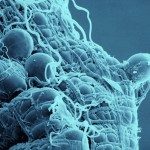Link to Pubmed [PMID] – 23486612
Mol. Biol. Evol. 2013 Jun;30(6):1263-9
Gene duplication generates genetic novelty and redundancy and is a major mechanism of evolutionary change in bacteria and eukaryotes. To date, however, gene duplication has been reported only rarely in RNA viruses. Using a conservative BLAST approach we systematically screened for the presence of duplicated (i.e., paralogous) proteins in all RNA viruses for which full genome sequences are publicly available. Strikingly, we found only nine significantly supported cases of gene duplication, two of which are newly described here–in the 25 and 26 kDa proteins of Beet necrotic yellow vein virus (genus Benyvirus) and in the U1 and U2 proteins of Wongabel virus (family Rhabdoviridae). Hence, gene duplication has occurred at a far lower frequency in the recent evolutionary history of RNA viruses than in other organisms. Although the rapidity of RNA virus evolution means that older gene duplication events will be difficult to detect through sequence-based analyses alone, it is likely that specific features of RNA virus biology, and particularly intrinsic constraints on genome size, reduce the likelihood of the fixation and maintenance of duplicated genes.

